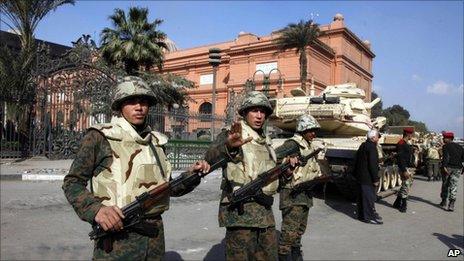Egyptian Museum: Cairo's looted treasure
- Published

For lovers of ancient history, the Egyptian Museum and the priceless, cultural treasures it contains have been in alarmingly close proximity to troubles in Cairo's Tahrir Square.
Following an inventory, Antiquities Minister Zahi Hawass has now confirmed for the first time that artefacts were stolen during a break-in on 28 January.
In a statement entitled "sad news", he lists 18 items that have disappeared. They include a gilded wood statue of the boy king Tutankhamun being carried by a goddess and parts of another statue of him harpooning.
A criminal investigation has begun to try to recover the valuable objects. A group of men already in custody is being questioned.
The raid on the museum took place at the height of a period of lawlessness after police were removed from the streets.
The office of Mr Hawass confirmed that 70 artefacts were knocked over or damaged when showcases were broken. Pictures on state television showed shattered glass and items overturned on the floor.
Two unidentified skulls, being kept in storage in the museum grounds for examination by researchers, were retrieved in their original condition. It has been reported that they were mummies that had been damaged.
Soldiers have guarded the museum since the raid. They could be seen putting out fires started by petrol bombs that landed in the garden, when anti-government protesters fought with gangs supporting President Hosni Mubarak.
On his official blog, Mr Hawass, wrote: "I have said that if the Egyptian Museum is safe, Egypt is safe. However, I am now concerned Egypt is not safe."
But he later added: "Not a single thing has been thrown at the museum by the thousands of protesters in Tahrir Square, because these people do not want to damage their cultural heritage."
A date for the Egyptian Museum to open has not yet been decided. Its director and other staff have been sleeping at the site to watch over it.
'Confidence dented'
The red, neoclassical building on Tahrir Square houses the golden treasures of Tutankhamun discovered in his nearly intact tomb in 1922, as well as other world-famous pharaonic artefacts.
Other ancient sites, popular with the millions of tourists who come to Egypt each year, have also been affected by recent unrest.
Antiquities workers say intruders tried to enter the Coptic Museum in old Cairo and the Royal Jewellery Museum in Alexandria on 29 January.
A padlock was broken at the site of the open-air museum in Memphis, south of Cairo, although nothing was stolen.
There was also a break-in at a building near a "crooked pyramid" at Dahshur, also south of Cairo.
The army continues to surround the site of the pyramids and the Sphinx at Giza.
The ancient monuments are usually a highlight for visitors on historic tours of Egypt. However, officials say about 1.2m tourists were driven away by recent political turmoil.
A continuing state of uncertainty may also dent the confidence of international museums currently considering returning "unique cultural objects" from Egypt on loan for the opening of the new Giza Museum due by 2013.
Egyptian officials have requested the return of the Rosetta Stone from the British Museum and the bust of Queen Nefertiti from the Neues Museum in Berlin, Germany.